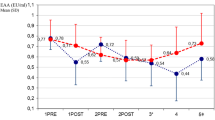Abstract
The objective of this study was to analyze retrospectively the efficacy of polymyxin-B immobilized fiber (PMX-F) alone and in combination with continuous venovenous hemofiltration (CHF) on the prognosis of critically ill patients with sepsis using a retrospective chart review in a university hospital in Japan. A cohort of 246 patients meeting the criteria of sepsis, septic shock, or both, according to the American College of Chest Physicians/Society of Critical Care Medicine (ACCP/ACCM) Consensus Conference, were examined in this study. From these patients, 48 were selected who were found to have definitive causative bacteria and whose primary diseases were clearly identified. According to the charts, two major primary diseases were identified: one related to cardiovascular disease and the other to gastrointestinal disease. Other diseases were excluded from this study because of the small numbers of patients in categories such as malignant, hematological, genitourinary, and other diseases. Furthermore, patients who had levels of serum creatinine above 2.0 mg/dl were excluded. The prevalence of diabetes mellitus (up to 63%) was very high in both groups. There were no significant differences between the two groups in age or the Apache II scores at the start of hemoperfusion treatment; however, the gender ratio varied: 72% of the cardiovascular group were male, compared to 46% of the gastrointestinal group. The causative bacteria were markedly different between the two groups. For half of the gastrointestinal group the causative bacterium was Escherichia coli, while for half of the cardiovascular group the causative bacterium was Pseudomonas aeruginosa.
The survival rate differed significantly between the two groups. The patients in the cardiovascular group survived longer than those in the gastrointestinal group. Moreover, for the patients with cardiovascular disease, there was no significant difference in the survival rate between treatment with PMX-F alone and with PMX-F and CHF in combination. In contrast, for the patients with gastrointestinal disease, there was a significant difference between treatment with PMX-F alone and with PMX-F and CHF in combination. When a patient with sepsis or septic shock is treated with hemoperfusion, the decision as to whether PMX-F should be given alone or in combination with CHF might be determined on the basis of the primary disease of the patient.
Similar content being viewed by others
Author information
Authors and Affiliations
Corresponding author
Rights and permissions
About this article
Cite this article
Kanno, Y., Nemoto, H., Nakamoto, H. et al. Selection of hemoperfusion therapy for patients with septic shock on the basis of the primary disease. J Artif Organs 6, 205–210 (2003). https://doi.org/10.1007/s10047-003-0222-z
Received:
Accepted:
Issue Date:
DOI: https://doi.org/10.1007/s10047-003-0222-z




